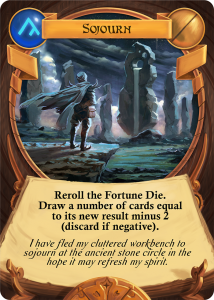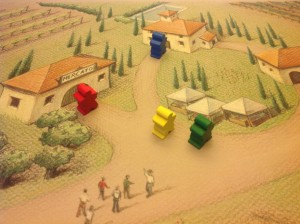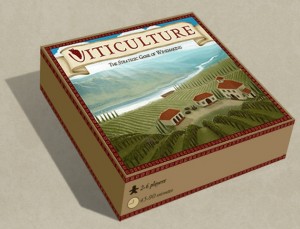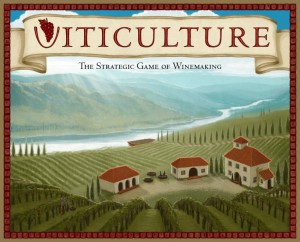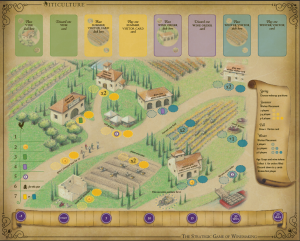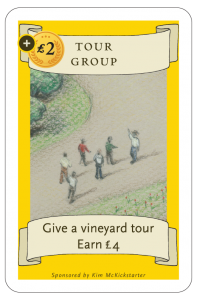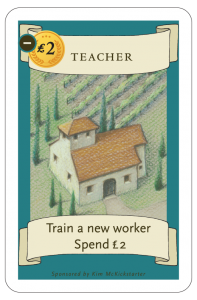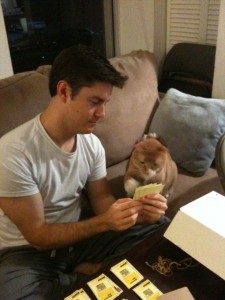Continuing my series, I’m going through the Kickstarter projects I’ve backed, in chronological order, noting why I backed each project, what level I backed at, and how it turned out. Part 1 of the series, covering the first 10 games I backed on Kickstarter, is here.
11. Roll20 Virtual Tabletop – April 2012
Why I pledged: At the time, I was still running a D&D game online using MapTool. I love MapTool, but Roll20 seemed like a cool attempt at a new, user-friendly virtual tabletop, and I wanted to see it become a reality.
My pledge: $25 for access to the closed beta and input on the development process (although I didn’t actually care about the reward all that much).
How it turned out: Roll20.net is a fantastic virtual tabletop, and I say this even though I don’t run D&D games online any more. I have only personally used Roll20 for playtesting the Substances expansion to Chaos & Alchemy, but the fact that the tool was flexible enough for that sort of thing is amazing.
12. Sentinels of the Multiverse Enhanced Edition – May 2012
Why I pledged: I had heard good things about the game, and it looked like a lot of fun. I also liked that it seemed the creators had put out a good-but-not-great package for their first edition and that this edition would be better.
My pledge: $50 for the new core game (no extra expansions)
How it turned out: Awesome! I was able to pick up my copy of the game at Gen Con 2012, and while I’ve only played it a few times so far, I think it’s a lot of fun.
13. Midgard Bestiary for 4th Edition – July 2012
Why I pledged: Partly because some people I follow online were associated with it, but mainly to show my support for 4th Edition D&D after D&D Next was announced.
My pledge: $10 for a PDF of the book
How it turned out: I received the PDF. I flipped through it a bit but have never actually used it. Still, I showed my support, and it was only $10, so I feel good about backing the project.
14. Project Ninja Panda Taco – July 2012
Why I pledged: Because I love the Jennisodes podcast, and I wanted to support Jenn. I also wanted to support Brian Patterson, the artist for the book who also draws d20 Monkey.
My pledge: $50 for a signed book (plus some bonus doo-dads that I don’t really care about).
How it turned out: Super cool! I read the book cover to cover, and I think it’s adorable. I haven’t actually played the game, and I likely never will, but this was money well spent.
15. Race to Adventure – July 2012
Why I pledged: I like Evil Hat, the game looked like fun, and I wanted to support Daniel Solis’s graphic design work.
My pledge: $40 for a copy of the game, plus some extras.
How it turned out: Ultimately disappointing. Among the extras were PDFs of Spirit of the Century and Dinocalypse Now, both of which were absolutely fantastic and completely unexpected. The game arrived in a timely manner, and it’s really beautiful and professionally produced. Unfortunately, the game is no fun at all. It’s just boring. I ended up giving it to my young niece and nephew, who seem to enjoy it.
16. Dungeon World – June 2012
Why I pledged: Mostly because everyone else was pledging, and heck, it was just five bucks to get the PDF – why not? As a side note, I’m listing the end dates for these campaigns, so even though Dungeon World says June 2012 while number 14 and 15 on my list say July, I actually backed Dungeon World after the other two.
My pledge: $5 for the PDF of the game
How it turned out: I believe I downloaded the preview version of the PDF when it was available. It seemed massive. I never actually read it, nor did I download the final version. But for five bucks, I’m fine with how things turned out.
17. Fantastiqa – August 2012
Why I pledged: I like deckbuilding games, and this one seemed like something that might appeal to more of the people I play with given its lighter theme. I loved the artwork, too.
My pledge: $72 for the game and its expansions
How it turned out: Disappointing. I know that this game generally gets good reviews, and I’ll admit that I’ve only played it a couple of times. But so far, it’s just not much fun. It feels like it has too many moving parts for a game that seems to hold itself out as being a little bit simpler than other deckbuilders. I think it stripped out the complexity that I enjoy in other deckbuilding games while adding complexity (fiddliness) that I don’t enjoy. I plan to find a new home for this one (anyone want to trade it for something cool?).
18. Consequential – August 2012
Why I pledged: I tried a demo of this game at Gen Con and thought it was really, really cool (despite the video stuff, not because of it). Also, I like Asmadi Games in general (particularly Innovation).
My pledge: $42 for a copy of the game
How it turned out: The project was canceled, unfortunately. This was a surprise to me. It also surprised me that they still haven’t re-launched it yet, although a recent BGG post from the designer says that they’ll be re-launching in September 2013. Hm, we’re in October now. Oh well; I’m guessing we’ll see it someday.
19. Viticulture – October 2012
Why I pledged: I love worker placement games. I love wine. And the project seemed really well put together.
My pledge: $49 for a copy of the game.
How it turned out: Awesome! First of all, the game itself is fantastic – one of the best marriages of theme and mechanics I’ve seen in a board game. Seriously, the way wines become more valuable as they age is super-elegant. Second, being involved with this project has led to a great working relationship with Jamey Stegmaier of Stonemaier Games, and it was a blast getting to meet him and his friends at Gen Con 2013.
20. Numenera – September 2012
Why I pledged: This is another one where following the herd played a role. So many people were talking about the game, I figured it was worth getting in for the PDF.
My pledge: $20 for PDFs of the core game and the Player’s Guide.
How it turned out: Honestly, I don’t know. I received an email with a link to download the player’s guide, but not the core book. I don’t care about the player’s guide. I should really follow up with the publisher to get the core book link, but I realized that I don’t actually care enough to track it down. I’m just not that into RPGs these days, and to the degree that I am into them, there are other games that I’m more interested in (at the moment, that’s D&D Next). I do hear good things about Numenera, though, so I’m not going to hold my personal RPG apathy against the game.
Scorecard for projects 11-20 that I backed:
- Number that were actually funded: 9/10
- Number that were eventually delivered: 9/9
- Number that I feel were ultimately worth it in retrospect: 7/9 (the two exceptions being Race to Adventure and Fantastiqa)
- Total money spent: $321
- Money spent on not-worth-it projects: $102
What’s next?
I’m still at 49 total backed projects, and I’d like to keep revisiting them in this manner. I can definitely do numbers 21-30 soon, but after that I’ll need to pause to let some of the later-backed projects reach their expected delivery dates. Only three of the projects in the 31-40 range have been delivered, and mostly because I backed them fairly recently – the most recent being in July 2013 – not because of problems with the projects.
I’m still interested in hearing from others who have backed a number of Kickstarter projects – what made you back them, and are you happy with your decision in retrospect?
Michael the OnlineDM
@ClayCrucible on Twitter

